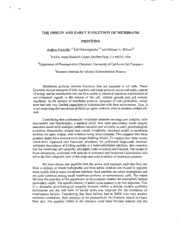
NASA Technical Reports Server (NTRS) 20050184164: The Origin and Early Evolution of Membrane Proteins PDF
Preview NASA Technical Reports Server (NTRS) 20050184164: The Origin and Early Evolution of Membrane Proteins
THE ORIGIN AND EARLY EVOLUTION OF MEMBRANE PROTEINS Andrew Pohorille,'B2K arl S~hweighofer,'a*n~d Michael A. Wilson'.' 'NASA-Ames Research Center, Moffett Field, CA 94035, USA 'Department of Pharmaceutical Chemistry, University of California San Francisco 3Research Institute for Advance Computational Science Membrane proteins mediate functions that are essential to all cells. These functions include transport of ions, nutrients and waste products across cell walls, capture of energy and its transduction into the form usable in chemical reactions, transmission of environmental signals to the interior of the cell, cellular growth and cell volume regulation. In the absence of membrane proteins, ancestors of cell (protocells), would have had only very limited capabilities to communicate with their environment. Thus, it is not surprising that membrane proteins are quite common even in simplest prokaryotic cells. Considering that contemporary membrane channels are large and complex, both structurally and functionally, a question arises how their presumably much simpler ancestors could have emerged, perform functions and diversify in early protobiological evolution. Remarkably, despite their overall complexity, structural motifs in membrane proteins are quite simple, with a-helices being most common. This suggests that these proteins might have evolved from simple building blocks. To explain how these blocks could have organized into functional structures, we performed large-scale, accurate computer simulations of folding peptides at a water-membrane interface, their insertion into the membrane, self-assembly into higher-order structures and function. The results of these simulations, combined with analysis of structural and functional experimental data led to the first integrated view of the origin and early evolution of membrane proteins. We have shown that peptides with the amino acid sequence such that they can form a-helices, in which hydrophobic and hydrophilic residues are located at opposite faces readily fold at water-membrane interface. Such peptides are called amphiphatic and are ,quite common among small membrane proteins in contemporary cells. The match between the polarities of the peptide and its environment renders the amphiphatic helices particularly stable. The specific identity of amino acids appears to be less important. This is a desirable protobiological property because neither a precise protein synthesis mechanism nor the full suite of amino acids was required for the formation of amphiphatic helices. Considering that these helices had to fulfill only very modest sequence constraints, their presence in the protocellu~are nvironment should not have been rare. The peptides folded at the interface could have become inserted into the membrane such that they spanned the lipid bilayer. While the insertion of an a-helix into a membrane is unfavorable, stability can be regained by specific recognition and association of peptides into larger assemblies. Examples of such assemblies are associations of 4 to 7 a-helices into ion-transporting channels. In contrast to folding and insertion, this process is strongly sequence-dependent. In fact, the ability to associate was probably one of the selection mechanisms operating on protocellular transmebrane peptides. We argue that the transport of solute species, especially ions, required an early evolution of efficient transport mechanisms, and that the emergence of simple ion channels was protobiologically plausible. We also argue that, despite their simple structure, such channels could possess properties that, at the first sight, appear to require markedly larger complexity. One example that will be discussed is a 25-amino acid fragment of the M2 protein of the influenza virus, which forms a tetrameric channel capable of efficient and selective transport of protons. Another example is a 16-residue peptaibol, antiamoebin, which is a simple structural analog to voltage-gated potassium channel, KvAP. Properties of these simple proteins can be subtly modulated by local modifications to the sequence rather than global changes in molecular architecture. This is a convenient evolutionary solution because it does not require imposing conditions on the whole amino acid sequence. In order to address the evolution and development of transmembrane ion channels, we identified protein domains that are commonly associated with ion channel proteins and are conserved throughout the three main domains of life: We argue that these domains have sufficiently universal architectures that they can readily adapt to the diverse functional demands arising during evolution. This work was supported by the NASA Exobiology Program.
